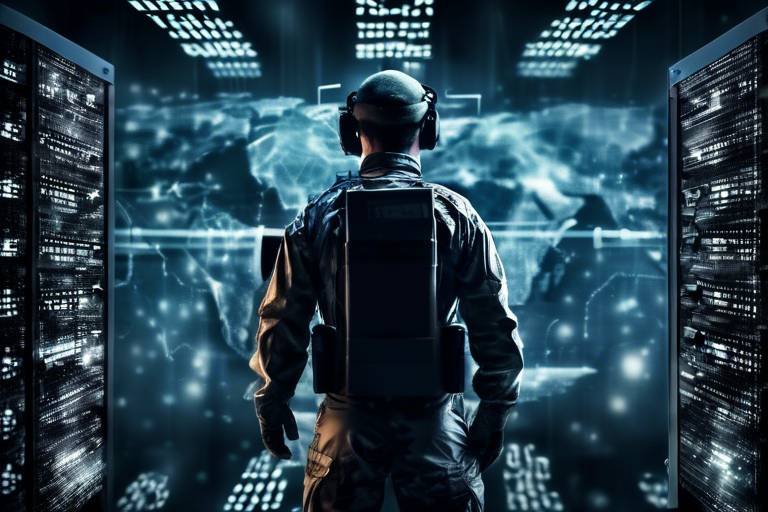How Modern Defense Systems are Addressing Cyber Threats
The digital age has ushered in a new era of connectivity and convenience, but it has also opened the floodgates to a myriad of cyber threats that can wreak havoc on organizations of all sizes. From small businesses to large corporations, no one is immune to these malicious attacks. With the stakes higher than ever, it’s imperative that modern defense systems evolve to not only keep pace with these threats but to outsmart them. So, how are contemporary defense systems addressing the complexities of cyber threats? Let’s dive in!
First off, it’s essential to understand that cyber threats come in many forms. Cybercriminals are becoming increasingly sophisticated, employing tactics that can bypass traditional security measures with ease. For instance, the rise of ransomware attacks has forced organizations to rethink their approach to data security. Imagine waking up to find that all your files have been encrypted, and the only way to regain access is to pay a hefty ransom. This scenario is no longer a figment of imagination; it's a harsh reality for many businesses today.
Moreover, phishing attacks have evolved as well. Gone are the days of poorly crafted emails asking for your password. Nowadays, these emails are so convincing that even the most cautious individuals can fall prey to them. The need for robust defense mechanisms is not just a luxury; it’s a necessity. But fear not! Modern defense systems are rising to the occasion, employing a multi-layered approach to combat these threats effectively.
One of the cornerstones of modern defense systems is the integration of cutting-edge technologies. For instance, Artificial Intelligence (AI) and Machine Learning (ML) are being harnessed to analyze patterns and detect anomalies in real-time. This proactive approach allows organizations to identify potential threats before they escalate into full-blown attacks. Think of AI as a vigilant guard dog, always on the lookout for any signs of trouble.
Another vital aspect is the emphasis on **collaboration** among various security tools and teams. Modern defense systems are not just standalone solutions; they work in harmony to create a fortified security environment. This collaborative effort ensures that if one layer of defense is breached, others are in place to provide backup. It’s akin to having multiple locks on your front door; if one fails, the others still protect your home.
In addition to technology and collaboration, **training and awareness** play a crucial role in modern defense strategies. Employees are often the first line of defense against cyber threats, and educating them about best practices can significantly reduce the risk of a successful attack. Regular training sessions and simulated phishing exercises can empower staff to recognize and respond to threats effectively. After all, a well-informed employee is an organization’s best asset in the fight against cybercrime.
To wrap it up, as cyber threats continue to evolve, so too must our defenses. Modern defense systems are rising to the challenge by integrating advanced technologies, fostering collaboration, and prioritizing employee training. The fight against cyber threats is ongoing, but with the right strategies in place, organizations can safeguard their sensitive data and infrastructure. Remember, in the world of cybersecurity, the best offense is a good defense!
- What are the most common types of cyber threats? Cyber threats can include ransomware, phishing attacks, malware, and denial-of-service attacks, among others.
- How can organizations improve their cybersecurity posture? Organizations can enhance their cybersecurity by implementing multi-layered defense strategies, investing in employee training, and utilizing advanced technologies like AI and machine learning.
- What is an Incident Response Team? An Incident Response Team is a group of professionals responsible for managing and mitigating the effects of a security breach.
- Why is employee training important in cybersecurity? Employees are often the first line of defense against cyber threats; educating them can help prevent breaches and reduce risks significantly.

The Rise of Cyber Threats
In today's digital age, the rise of cyber threats is not just a concern; it’s a reality that organizations across the globe must face. As technology evolves, so do the tactics employed by cybercriminals, leading to an alarming increase in the frequency and sophistication of these threats. From small businesses to large corporations, no one is immune to the potential risks posed by malicious actors lurking in the shadows of the internet. Understanding this landscape is crucial for developing effective defense strategies that can safeguard sensitive data and critical infrastructure.
Cyber threats come in various forms, each with its own unique characteristics and methods of attack. For instance, phishing attacks have become increasingly sophisticated, often masquerading as legitimate communications to trick unsuspecting individuals into revealing personal information. Similarly, ransomware attacks have skyrocketed, where hackers encrypt an organization’s data and demand a ransom for its release, leaving companies vulnerable and often scrambling to recover their operations.
Moreover, the rise of Internet of Things (IoT) devices has introduced new vulnerabilities. With more devices connected to the internet than ever before, the potential attack surface has expanded dramatically. Each connected device can serve as a gateway for cybercriminals, making it essential for organizations to implement stringent security measures across all their digital assets.
Another concerning trend is the emergence of state-sponsored cyber attacks, where nation-states engage in cyber warfare to disrupt or steal information from rival countries or corporations. These attacks are often well-funded and meticulously planned, making them particularly challenging to defend against. The implications of such attacks can be devastating, affecting not just individual organizations but entire economies.
To illustrate the diversity of cyber threats, consider the following table that categorizes some of the most prevalent types:
| Type of Cyber Threat | Description |
|---|---|
| Phishing | Fraudulent attempts to obtain sensitive information by disguising as a trustworthy entity. |
| Ransomware | Malware that encrypts files and demands payment for decryption. |
| Malware | Malicious software designed to harm, exploit, or otherwise compromise a computer system. |
| Denial-of-Service (DoS) | Attacks aimed at making a machine or network resource unavailable to its intended users. |
| Insider Threats | Threats posed by individuals within the organization who misuse their access to information. |
As we delve deeper into the world of cyber threats, it becomes evident that a proactive approach is necessary. Organizations must not only recognize the existence of these threats but also understand their potential impact. This awareness is the first step in crafting a robust cybersecurity strategy that can withstand the evolving landscape of cybercrime. By staying informed about the latest trends and implementing comprehensive security measures, businesses can better protect themselves against the relentless tide of cyber threats.
- What are the most common types of cyber threats? The most common types include phishing, ransomware, malware, denial-of-service attacks, and insider threats.
- How can organizations protect themselves from cyber threats? Organizations can protect themselves by implementing strong security measures, conducting regular security audits, and training employees on recognizing potential threats.
- What role does employee awareness play in cybersecurity? Employee awareness is crucial, as many cyber attacks exploit human error. Training staff to recognize threats can significantly reduce vulnerability.

Key Components of Modern Defense Systems
In today's digital landscape, where threats lurk around every corner, modern defense systems have become the backbone of cybersecurity. These systems are not just a collection of tools; they represent an intricate web of technologies and methodologies designed to fend off the ever-evolving tactics of cybercriminals. But what exactly makes up these advanced security frameworks? Let's dive into the key components that are essential for effective cybersecurity.
At the heart of modern defense systems lies the concept of layered security. This approach, often referred to as "defense in depth," ensures that if one security measure fails, others are in place to catch the threat. Imagine this as a fortress: the outer walls provide initial protection, but there are also moats, guards, and inner walls that add additional layers of defense. Similarly, modern defense systems utilize a combination of technologies and practices to create multiple barriers against potential attacks.
One of the most critical components is the Intrusion Detection System (IDS). This technology acts as the vigilant watchman of your network, constantly monitoring for suspicious activity. An IDS can alert administrators to unauthorized access attempts, allowing for swift action to mitigate potential damage. However, it’s important to understand that an IDS is only as effective as the data it analyzes. This is where threat intelligence comes into play. By gathering and analyzing data on emerging threats, organizations can enhance the capabilities of their IDS, making it more adept at recognizing and responding to new attack vectors.
Furthermore, modern defense systems integrate advanced firewall technologies to filter incoming and outgoing traffic based on predetermined security rules. Firewalls serve as the first line of defense against cyber threats, blocking unauthorized access while allowing legitimate traffic to flow freely. Think of a firewall as the security checkpoint at an airport—only those who meet specific criteria are allowed through.
Another essential component is endpoint protection. With the rise of remote work and mobile devices, securing endpoints has become paramount. Endpoint protection solutions not only safeguard individual devices but also ensure that they do not become entry points for cybercriminals. This is similar to having a personal security detail for each employee, ensuring they are protected no matter where they are working from.
To visualize the interconnectedness of these components, consider the following table that outlines their roles:
| Component | Role |
|---|---|
| Intrusion Detection System (IDS) | Monitors network traffic for suspicious activity |
| Firewalls | Filters traffic to prevent unauthorized access |
| Endpoint Protection | Secures individual devices against threats |
| Threat Intelligence | Analyzes data to predict and mitigate threats |
In addition to these components, organizations must also focus on security awareness training for their employees. Human error remains one of the leading causes of security breaches. By educating staff on best practices, organizations can create a culture of security that complements their technological defenses. This training can be likened to teaching someone how to navigate a minefield—knowledge is the key to avoiding disaster.
In conclusion, the key components of modern defense systems are multifaceted and interdependent. From Intrusion Detection Systems to firewalls and endpoint protection, each element plays a vital role in creating a robust cybersecurity posture. As cyber threats continue to evolve, so must our defense strategies, ensuring that we stay one step ahead of those who seek to exploit vulnerabilities.
- What is an Intrusion Detection System (IDS)?
An IDS is a device or software application that monitors a network or systems for malicious activity or policy violations. - How do firewalls work?
Firewalls act as barriers between trusted and untrusted networks, filtering traffic based on security rules. - Why is endpoint protection important?
With the increase in remote work, endpoint protection is crucial for securing devices that connect to the corporate network. - What is threat intelligence?
Threat intelligence involves gathering and analyzing information about potential threats to improve security measures.

Intrusion Detection Systems (IDS)
In today's digital age, where data breaches and cyber threats loom large, have emerged as a critical line of defense. Imagine your home with a state-of-the-art security system that alerts you to any unauthorized entry. Similarly, IDS acts as a vigilant guardian for your network, constantly monitoring for suspicious activities and potential breaches. But how does it work, and why is it essential for a comprehensive cybersecurity strategy?
At its core, an IDS functions by analyzing network traffic and system activities for signs of malicious behavior. It operates on the principle of detection, alerting administrators about possible intrusions based on predefined rules or learned behaviors. These systems can identify a variety of threats, from unauthorized access attempts to malware infections. The effectiveness of an IDS hinges on its ability to differentiate between normal and abnormal activities, akin to how a security guard recognizes familiar faces versus intruders.
Moreover, IDS can be categorized into two main types: Network-based IDS (NIDS) and Host-based IDS (HIDS). NIDS monitors traffic across the entire network, analyzing packets flowing in and out, while HIDS focuses on individual devices, checking for unusual changes or unauthorized access attempts at the host level. This dual approach ensures that organizations have a comprehensive view of their security landscape, much like having both a neighborhood watch and a personal security detail.
However, implementing IDS is not without its challenges. One of the primary hurdles organizations face is the occurrence of false positives. Imagine receiving a security alert every time a leaf rustles in the wind; it can quickly lead to alarm fatigue, where genuine threats may be overlooked. To combat this, organizations must fine-tune their IDS settings and continuously update their detection algorithms to minimize false alarms. Additionally, resource allocation can be a concern, as effective IDS requires both technological investment and skilled personnel to interpret the data accurately.
In summary, Intrusion Detection Systems are indispensable tools in the fight against cyber threats. They not only provide real-time alerts but also contribute to a deeper understanding of potential vulnerabilities within an organization's infrastructure. By leveraging the insights gained from IDS, businesses can enhance their overall cybersecurity posture and ensure a safer digital environment.
- What is the primary function of an IDS? The primary function of an IDS is to monitor network traffic and system activities for signs of unauthorized access or malicious behavior.
- What are the two main types of IDS? The two main types are Network-based IDS (NIDS) and Host-based IDS (HIDS).
- What challenges do organizations face when implementing IDS? Organizations often face challenges such as false positives and the need for adequate resource allocation.
- How can false positives be minimized? False positives can be minimized by fine-tuning IDS settings and updating detection algorithms regularly.

Types of IDS
When it comes to safeguarding digital assets, understanding the different types of Intrusion Detection Systems (IDS) is crucial. Each type serves a unique purpose and employs various methodologies to detect unauthorized access and potential threats. The two primary categories of IDS are network-based IDS (NIDS) and host-based IDS (HIDS). Let's dive into these categories to see how they operate and where they excel.
Network-Based Intrusion Detection Systems (NIDS) monitor network traffic for suspicious activity. Think of NIDS as a security camera placed at the entrance of a building; it watches everything that comes in and out. By analyzing data packets traveling through the network, NIDS can identify patterns that may indicate a cyber attack, such as unusual spikes in traffic or attempts to access restricted areas. This type of IDS is particularly effective for organizations with extensive networks, as it provides a broad view of potential threats across multiple devices.
On the other hand, Host-Based Intrusion Detection Systems (HIDS) focus on individual devices, such as servers or computers. Imagine HIDS as a personal bodyguard for each device. It monitors the system's logs, file integrity, and user activity, looking for signs of compromise. HIDS can detect anomalies that may not be visible to NIDS, such as unauthorized changes to system files or the execution of suspicious processes. This makes HIDS an essential component for organizations that handle sensitive data on specific machines.
To further clarify the differences, here's a quick comparison:
| Type of IDS | Focus Area | Strengths | Weaknesses |
|---|---|---|---|
| Network-Based IDS (NIDS) | Network Traffic | Broad monitoring across multiple devices | May miss attacks on individual hosts |
| Host-Based IDS (HIDS) | Individual Devices | Detailed monitoring of specific systems | Limited to the host it monitors |
Both types of IDS have their unique advantages and challenges. It’s not uncommon for organizations to implement a combination of NIDS and HIDS to create a more comprehensive security posture. By leveraging both systems, organizations can achieve a layered defense strategy that addresses vulnerabilities at multiple levels. This multi-faceted approach ensures that even if one system fails to detect an intrusion, the other may still catch it, significantly enhancing overall security.
In conclusion, understanding the types of IDS is essential for any organization looking to bolster its cybersecurity defenses. By recognizing how NIDS and HIDS operate and complement each other, businesses can better prepare themselves against the ever-evolving landscape of cyber threats. It’s like having both a security camera and a personal bodyguard—together, they provide a robust defense against potential intruders.

Challenges of IDS Implementation
Implementing Intrusion Detection Systems (IDS) is not without its hurdles. Organizations often find themselves grappling with a variety of challenges that can hinder the effectiveness of these critical security tools. One of the most significant issues is the occurrence of false positives. Imagine a smoke alarm that goes off every time someone boils water; it quickly becomes a nuisance, leading to alarm fatigue. In the world of cybersecurity, too many false alarms can cause security teams to overlook genuine threats, diminishing the overall effectiveness of the IDS.
Another challenge is resource allocation. Deploying an IDS requires not only financial investment but also human resources. Organizations must ensure they have skilled personnel to monitor the system, analyze alerts, and respond to incidents. This can be particularly daunting for smaller companies that may lack the budget or manpower to effectively manage an IDS. Furthermore, the complexity of modern networks means that organizations must invest in comprehensive training for their staff to handle the intricacies of these systems.
Moreover, the integration of IDS with existing security infrastructures can pose significant technical challenges. Organizations often have a patchwork of security solutions in place, and ensuring that an IDS can communicate effectively with these systems is crucial. This can require extensive customization and may lead to unforeseen compatibility issues, further complicating the implementation process.
To illustrate the challenges of IDS implementation, consider the following table that summarizes key obstacles:
| Challenge | Description |
|---|---|
| False Positives | Frequent alerts that may distract from real threats, leading to alarm fatigue. |
| Resource Allocation | Need for skilled personnel and financial resources to manage the IDS effectively. |
| Integration Issues | Challenges in ensuring compatibility with existing security solutions. |
In addition to these challenges, organizations must also consider the evolving nature of cyber threats. Cybercriminals are constantly developing new tactics to bypass security measures, which means that an IDS must be regularly updated and fine-tuned to remain effective. This ongoing need for adaptation can stretch resources even thinner, making it imperative for organizations to stay ahead of the curve.
To overcome these challenges, organizations should adopt a proactive approach. This could involve investing in advanced machine learning algorithms that can help reduce false positives, as well as ensuring that there is a clear incident response plan in place. By understanding and addressing these obstacles, organizations can better leverage IDS technology to protect their digital assets.
- What is an Intrusion Detection System (IDS)?
An IDS is a security tool that monitors network traffic for suspicious activity and alerts administrators to potential threats. - What are the main types of IDS?
The two main types are network-based IDS (NIDS) and host-based IDS (HIDS), each serving different purposes in security monitoring. - How can false positives be minimized in an IDS?
Employing advanced analytics and tuning the system to recognize normal traffic patterns can help reduce the occurrence of false alerts. - Why is resource allocation important for IDS?
Effective monitoring and response to alerts require skilled personnel and financial resources to maintain the system's efficacy.

Threat Intelligence and Analysis
In today’s digital landscape, where cyber threats are lurking around every corner, threat intelligence has become a cornerstone of effective cybersecurity strategies. But what exactly is threat intelligence? Simply put, it’s the process of collecting, analyzing, and interpreting data related to potential or existing threats. This information is critical for organizations looking to stay one step ahead of cybercriminals. Think of it as a modern-day crystal ball that provides insights into the ever-evolving tactics of hackers.
Organizations can harness threat intelligence in several ways to enhance their cybersecurity posture. For instance, by understanding the methods and motives behind cyber attacks, companies can tailor their defenses to address specific vulnerabilities. This proactive approach not only helps in identifying potential threats but also allows organizations to prioritize their security efforts effectively. Imagine trying to defend a castle without knowing where the enemy might strike—without threat intelligence, that’s precisely the scenario many businesses face.
One of the key benefits of threat intelligence is its ability to provide context. It’s not just about knowing that a threat exists; it’s about understanding the who, what, when, and how of that threat. By analyzing historical data and current trends, organizations can anticipate future attacks and strengthen their defenses accordingly. This analysis can include various factors such as:
- The types of malware being used
- The geographical locations of threat actors
- Common vulnerabilities being exploited
- Patterns in attack vectors
Moreover, the integration of threat intelligence into a cybersecurity framework allows for a more dynamic response to incidents. Instead of relying solely on reactive measures, organizations can implement a continuous monitoring system that adjusts defenses based on real-time threat data. This is akin to having a security guard who not only watches for intruders but also understands their tactics and can predict their next move.
However, it’s essential to note that not all threat intelligence is created equal. Organizations must focus on obtaining high-quality, actionable intelligence that is relevant to their specific environment. This can often involve collaboration with external threat intelligence providers, sharing information with industry peers, and leveraging government resources. By doing so, businesses can enhance their situational awareness and make informed decisions that bolster their cybersecurity defenses.
As we delve deeper into the world of threat intelligence, it’s important to recognize the role of automation and machine learning. These technologies can significantly enhance the efficiency of data analysis, allowing organizations to sift through vast amounts of information quickly. By automating the collection and analysis process, cybersecurity teams can focus on strategic initiatives rather than getting bogged down in the minutiae of data processing.
In conclusion, threat intelligence and analysis are not just buzzwords in the cybersecurity realm; they are vital components that empower organizations to defend against an increasingly sophisticated array of cyber threats. By investing in robust threat intelligence capabilities, companies can not only react to threats more effectively but also anticipate and mitigate them before they escalate into full-blown incidents. In a world where the stakes are high, having the right information at the right time can make all the difference.
- What is threat intelligence? Threat intelligence is the process of collecting and analyzing data related to potential or existing cyber threats to enhance security measures.
- How can organizations use threat intelligence? Organizations can use threat intelligence to understand the tactics of cybercriminals, prioritize security efforts, and implement proactive defenses.
- What are the benefits of integrating threat intelligence? Integrating threat intelligence allows for a dynamic response to threats, improved situational awareness, and enhanced decision-making in cybersecurity.
- Is all threat intelligence reliable? No, organizations should focus on obtaining high-quality, relevant, and actionable intelligence to effectively bolster their cybersecurity posture.

Incident Response Strategies
In today's digital landscape, where cyber threats loom large, having a robust incident response strategy is not just a luxury—it's a necessity. Imagine your organization as a fortress, and the incident response plan is your moat and drawbridge, designed to protect against unexpected invasions. When a cyber attack occurs, the clock starts ticking, and the effectiveness of your response can mean the difference between a minor inconvenience and a catastrophic breach. So, how do organizations prepare for these high-stakes situations?
The first step in crafting an effective incident response strategy is understanding the key elements that make it successful. A well-structured plan typically includes preparation, identification, containment, eradication, recovery, and lessons learned. Each of these phases plays a critical role in ensuring that your organization can respond swiftly and effectively to any cyber incident.
Preparation is all about laying the groundwork. This involves training your team, establishing communication protocols, and ensuring that all necessary tools and resources are at hand. Think of it as conducting fire drills; the more prepared you are, the quicker and more efficiently you can act when the real thing happens. But preparation alone isn’t enough. Organizations must also focus on identification, which involves recognizing that a breach has occurred. This can be tricky, as cyber threats often hide in plain sight. Implementing systems like Intrusion Detection Systems (IDS) can help in spotting unusual activities that may indicate a breach.
Once a threat is identified, the next step is containment. This is where the incident response team swings into action, isolating affected systems to prevent further damage. It’s akin to sealing off a leaking pipe before the entire house floods. After containment, the focus shifts to eradication, where the root cause of the incident is identified and removed. This step is crucial; if the underlying issue isn’t addressed, you might find yourself facing the same attack again.
Recovery is the stage where systems are restored to normal operations. It’s essential to ensure that all vulnerabilities are patched and that the systems are fortified against future attacks. Finally, the lessons learned phase is where organizations reflect on the incident to improve their defenses. This is not just about fixing what went wrong, but also about enhancing the overall incident response strategy for the future.
One of the cornerstones of an effective incident response strategy is the establishment of a dedicated incident response team (IRT). This team is not just a group of IT professionals; it’s a multidisciplinary unit that includes members from various departments such as IT, legal, human resources, and public relations. Each member has specific roles and responsibilities that contribute to the overall response effort. For instance, while IT staff may focus on technical containment and eradication, the legal team might handle compliance and regulatory issues that arise during a breach.
Collaboration is key here. An incident response team that works well together can significantly reduce the time it takes to respond to an incident. Regular training and simulation exercises can help team members understand their roles better and improve communication during an actual incident.
After any cyber incident, conducting a thorough post-incident review is essential. This step is akin to a sports team reviewing game footage after a loss; it allows organizations to analyze what went wrong and what could have been done better. During this review, it's important to gather all relevant data and insights from the incident. This includes timelines, actions taken, and the effectiveness of the response. The goal is to identify gaps in the incident response plan and make necessary adjustments.
Furthermore, organizations should consider creating a lessons learned report that details the incident, the response, and the recommendations for future improvements. This document not only serves as a valuable resource for the incident response team but can also be shared with stakeholders to foster transparency and trust.
- What is an incident response strategy? An incident response strategy is a plan that outlines how an organization will respond to cyber incidents to minimize damage and recover effectively.
- Why is an incident response team important? An incident response team is crucial for managing and mitigating the effects of cyber incidents, ensuring a coordinated and efficient response.
- What are the key phases of incident response? The key phases include preparation, identification, containment, eradication, recovery, and lessons learned.
- How often should incident response plans be reviewed? Incident response plans should be reviewed regularly, ideally after each incident, and updated based on new threats and organizational changes.

Establishing an Incident Response Team
In today's digital landscape, where cyber threats lurk around every corner, having a dedicated Incident Response Team (IRT) is not just a luxury—it's a necessity. Think of your IRT as the firefighters of your organization's digital infrastructure; they're the first responders who rush in to tackle the blaze when a cyber incident strikes. But what exactly does establishing such a team entail?
First and foremost, it's essential to define the roles and responsibilities within the team. An effective IRT typically includes various members, each bringing unique expertise to the table. For instance, you might have:
- Incident Manager: Oversees the response process and coordinates between different teams.
- Security Analysts: Detect and analyze the nature of the threat.
- Forensic Experts: Investigate the breach and gather evidence.
- Communications Officer: Manages internal and external communications during an incident.
Establishing clear roles ensures that everyone knows what to do when the alarm bells ring. Additionally, it's crucial that team members are not only skilled but also trained to work together seamlessly. Regular drills and simulations can help your team practice their response to various scenarios, ensuring they are well-prepared when a real incident occurs.
Next, consider the tools and technologies your IRT will need. This might include advanced monitoring systems, communication platforms, and forensic analysis tools. Investing in the right technology can significantly enhance your team's ability to respond quickly and effectively. However, technology alone isn't enough. A well-documented incident response plan is vital. This plan should outline the steps to take during an incident, including identification, containment, eradication, recovery, and lessons learned.
Moreover, establishing a solid communication strategy is essential. During a cyber incident, information can change rapidly, and having a clear line of communication helps keep everyone on the same page. Consider setting up a dedicated communication channel for the IRT, allowing for real-time updates and discussions. This can be as simple as a group chat or as complex as a secure communication platform designed for incident management.
Finally, don't forget the importance of post-incident analysis. Once the dust has settled, the IRT should conduct a thorough review of the incident. This involves analyzing what went wrong, what went right, and how the response could be improved in the future. By documenting these findings and updating your incident response plan accordingly, you can bolster your defenses against future threats.
In summary, establishing an Incident Response Team is a multifaceted process that requires careful planning, clear communication, and continuous improvement. By investing time and resources into building a strong IRT, your organization can not only respond to incidents more effectively but also create a culture of cybersecurity awareness that permeates every level of your business.
- What is the primary role of an Incident Response Team? The IRT's main role is to manage and mitigate the impact of cyber incidents, ensuring a swift and effective response.
- How often should I conduct training for my IRT? Regular training sessions, ideally every few months, can help keep skills sharp and ensure that team members are familiar with the latest threats and response strategies.
- What tools are essential for an Incident Response Team? Essential tools include monitoring systems, forensic analysis software, and secure communication platforms.
- How can I measure the effectiveness of my IRT? Effectiveness can be measured through metrics such as response time, incident containment success, and the number of incidents handled over a specific period.

Post-Incident Review and Improvement
After a cyber incident, the dust doesn't just settle; it leaves behind a trail of valuable lessons. Conducting a thorough post-incident review is not just a box-ticking exercise—it's a critical step in fortifying your defenses against future attacks. Think of it as a strategic debrief, where your team gathers to dissect what happened, why it happened, and how to prevent it from happening again. This review process is akin to a sports team analyzing game footage to improve their performance. By understanding the play-by-play of the incident, organizations can identify vulnerabilities that were exploited and bolster their security posture.
One of the first steps in a post-incident review is to assemble a team that was involved in the incident response. This team should include members from various departments—IT, security, legal, and even public relations. Each perspective is crucial as it helps paint a complete picture of the incident and its impact on the organization. During this review, it's essential to address several key questions:
- What were the initial indicators of the breach?
- How was the incident detected and reported?
- What response actions were taken, and were they effective?
- What gaps in the response plan became apparent?
- How did the incident affect operations and stakeholders?
Gathering answers to these questions will not only illuminate the weaknesses in your current security measures but also highlight the strengths. For instance, if your team responded quickly and efficiently, that’s a win worth replicating in future strategies. Conversely, if delays were noted in communication or action, those areas will need immediate attention.
Another vital aspect of the post-incident review is documentation. Maintaining a detailed record of the incident, the response, and the lessons learned is essential for ongoing improvement. This documentation serves as a reference point for future incidents and can be invaluable for training new team members. It’s like having a playbook that outlines what strategies worked and which ones didn’t. Over time, this repository of knowledge can transform your organization’s approach to cybersecurity.
Finally, the review should culminate in an improvement plan. This plan should outline specific actions to address identified weaknesses, such as:
- Implementing new security protocols
- Enhancing employee training programs
- Investing in advanced security technologies
- Regularly updating incident response plans
By actively engaging in this continuous cycle of review and improvement, organizations can not only recover from incidents but also emerge stronger and more resilient. Remember, in the world of cybersecurity, complacency is the enemy. By learning from past experiences, you can build a fortress against future threats.
What is a post-incident review?
A post-incident review is an analysis conducted after a cybersecurity incident to evaluate what occurred, how the response was managed, and what improvements can be made for the future.
Why is documentation important in a post-incident review?
Documentation provides a detailed record of the incident and response actions taken, serving as a reference for future incidents and helping to train staff on best practices.
How often should post-incident reviews be conducted?
Post-incident reviews should be conducted after every significant incident, but organizations should also regularly review their security posture and incident response plans to adapt to evolving threats.
Frequently Asked Questions
-
What are the most common types of cyber threats today?
Cyber threats come in many forms, but some of the most common include malware, phishing, ransomware, and Denial of Service (DoS) attacks. Each of these threats poses unique risks to organizations, making it essential to stay informed and prepared.
-
How do Intrusion Detection Systems (IDS) work?
Intrusion Detection Systems (IDS) monitor network traffic for suspicious activity and policy violations. They analyze data packets and alert administrators when potential threats are detected, acting as a crucial line of defense against unauthorized access.
-
What are the different types of IDS?
There are primarily two types of IDS: network-based IDS (NIDS), which monitors network traffic for multiple devices, and host-based IDS (HIDS), which focuses on individual devices. Each type serves different purposes and can be used in tandem for enhanced security.
-
What challenges do organizations face when implementing IDS?
Implementing IDS can come with challenges like false positives, which can lead to alarm fatigue, and resource allocation issues, where organizations struggle to dedicate sufficient personnel and technology to monitor the systems effectively.
-
How does threat intelligence enhance cybersecurity?
Threat intelligence involves gathering and analyzing data on potential threats, allowing organizations to proactively defend against cyber attacks. By understanding emerging threats, companies can adjust their security measures and stay one step ahead of cybercriminals.
-
Why is an incident response team important?
An incident response team is essential for managing security breaches efficiently. This team is responsible for identifying the breach, containing it, and mitigating damage, ensuring that the organization can recover swiftly and effectively.
-
What steps should be taken after a cyber incident?
After a cyber incident, it's crucial to conduct a post-incident review. This involves analyzing what happened, identifying weaknesses in the security posture, and implementing improvements to prevent future incidents. Learning from past mistakes is key to strengthening defenses.



















